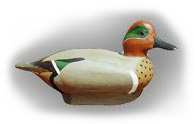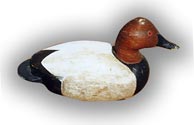by Laurence Rucker
 Pat O’Hagan, a third generation Irishman and decoy maker, was born in Deerlodge, Montana in 1958 and later moved with his family to Washington State. Eventually, he married, and he and his wife, Jane, settled in the town of Arlington, Washington, where they are raising five sons. Pat O’Hagan, a third generation Irishman and decoy maker, was born in Deerlodge, Montana in 1958 and later moved with his family to Washington State. Eventually, he married, and he and his wife, Jane, settled in the town of Arlington, Washington, where they are raising five sons.
O’Hagan carves and paints with accuracy, whether making a duck, a shorebird, a King salmon or a quail. He first lays out a pattern on western red cedar acquired from a local lumberyard. He also uses California redwood and Alaskan yellow cedar when they’re available. He then cuts out the decoy on a band saw. When making hollow decoys, both halves are hollowed with a drill press, and the keel is attached with screws from the inside before assembly. The head is attached in the same way, and then the two halves are glued together. The final shaping is accomplished with power tools. Pat applies a coat of waterproof sealant to provide the durability necessary for use on saltwater bays. The use of oil paints allows him to blend the colors in his paint patterns, which are purposely kept simple.
Throughout the years O’Hagan has carved almost all North American waterfowl, excepting a black duck and shoveler, but he still has plenty of time to accomplish them, although black ducks are not found out west. His repertoire of shorebirds includes dunlin, yellowlegs, avocet, turnstones, wimbrel, plover and red knot. Both hunters and collectors come calling, and the decoys are sold as quickly as they are made. Only his personal hunting rig generally remains in his shop.
 O’Hagan is not a decoy collector, but he readily admires the work of Shang Wheeler and the Ward brothers. He does own a few decoys by local carvers, such as David Hagerbaumer who lives just a few miles up the road. O’Hagan is not a decoy collector, but he readily admires the work of Shang Wheeler and the Ward brothers. He does own a few decoys by local carvers, such as David Hagerbaumer who lives just a few miles up the road.
Pat hopes that one of his five sons will some day take up carving. The boys love to hunt and have kept their dad in the field, although at times he’s felt like hanging up his guns. Sitting in a warm shop making decoys is sometimes more appealing than setting out decoys in a cold winter storm. Yet when there is a howling wind and driving snow, the urge to be out there often prevails
For the complete story, please see the May/June 2001 issue of Decoy Magazine.
Tidbits Main Index

|


